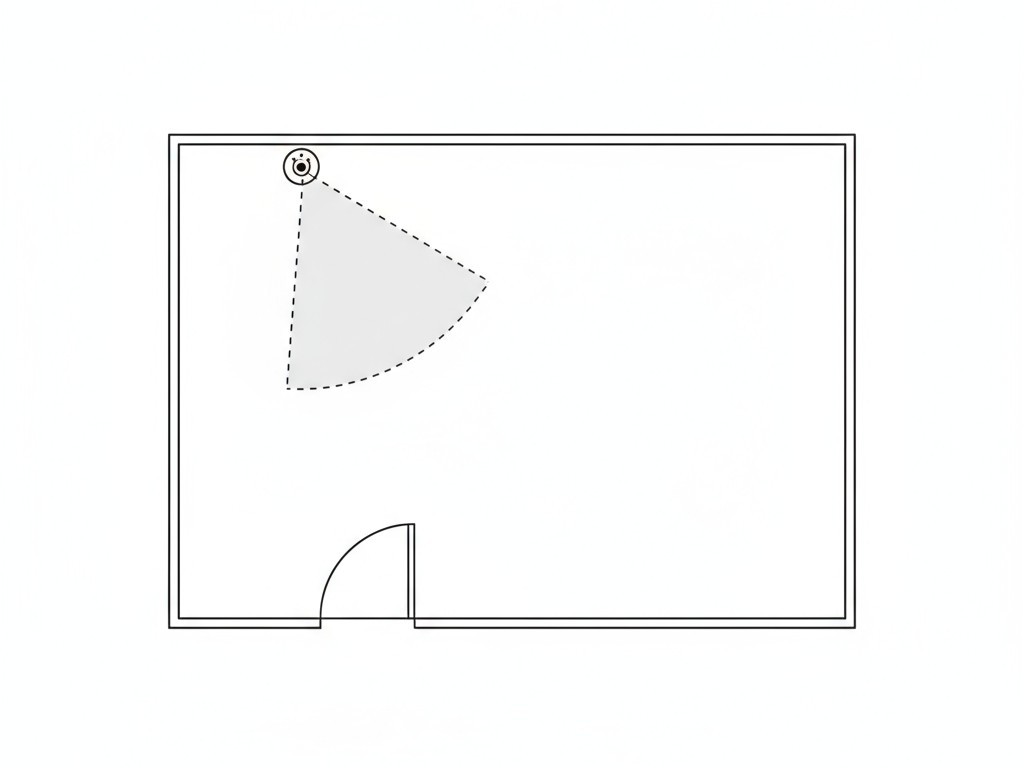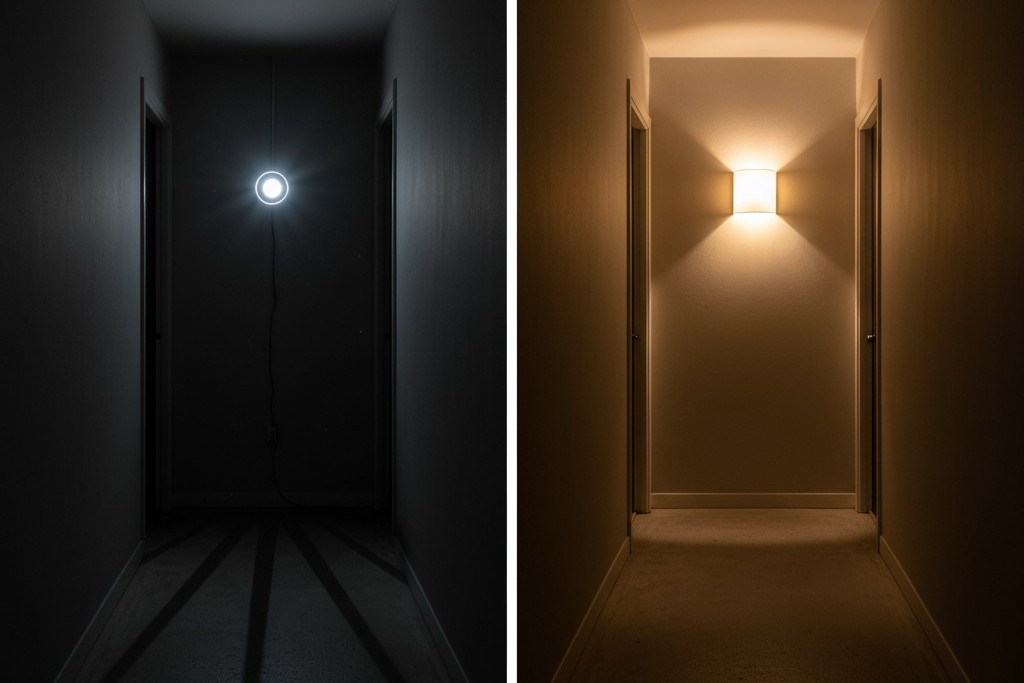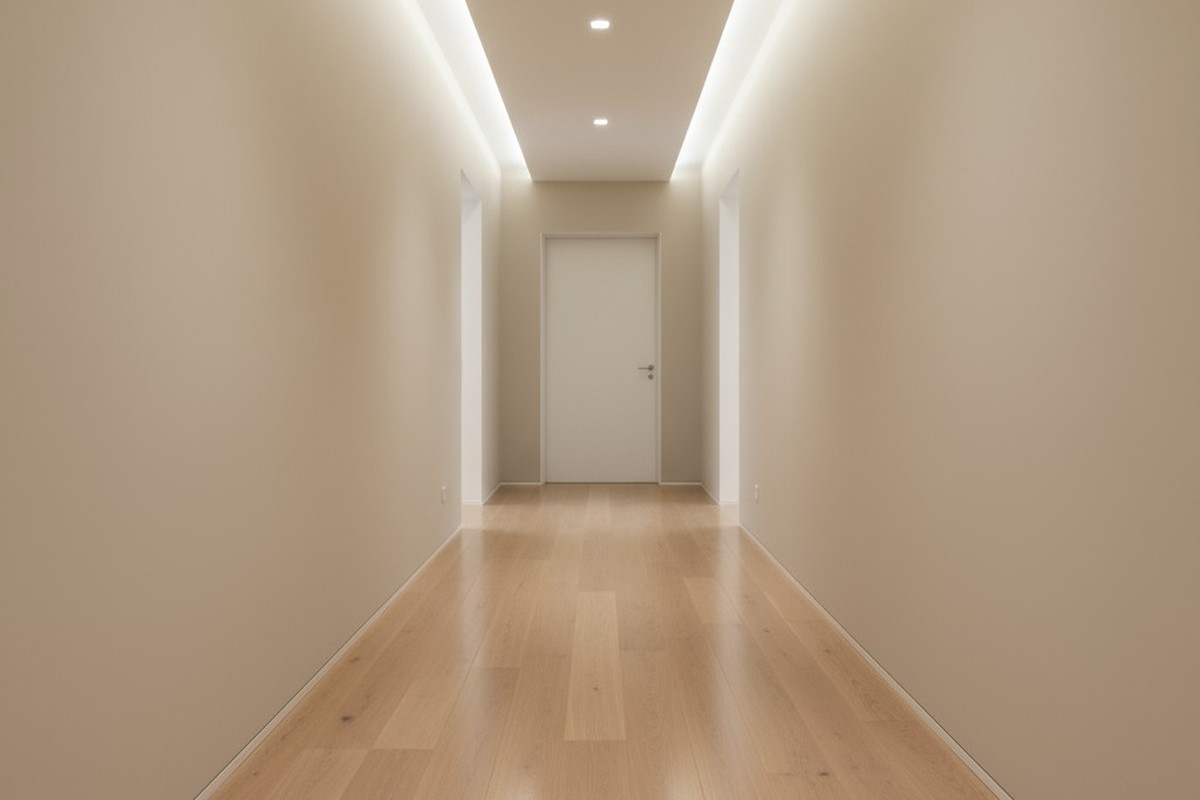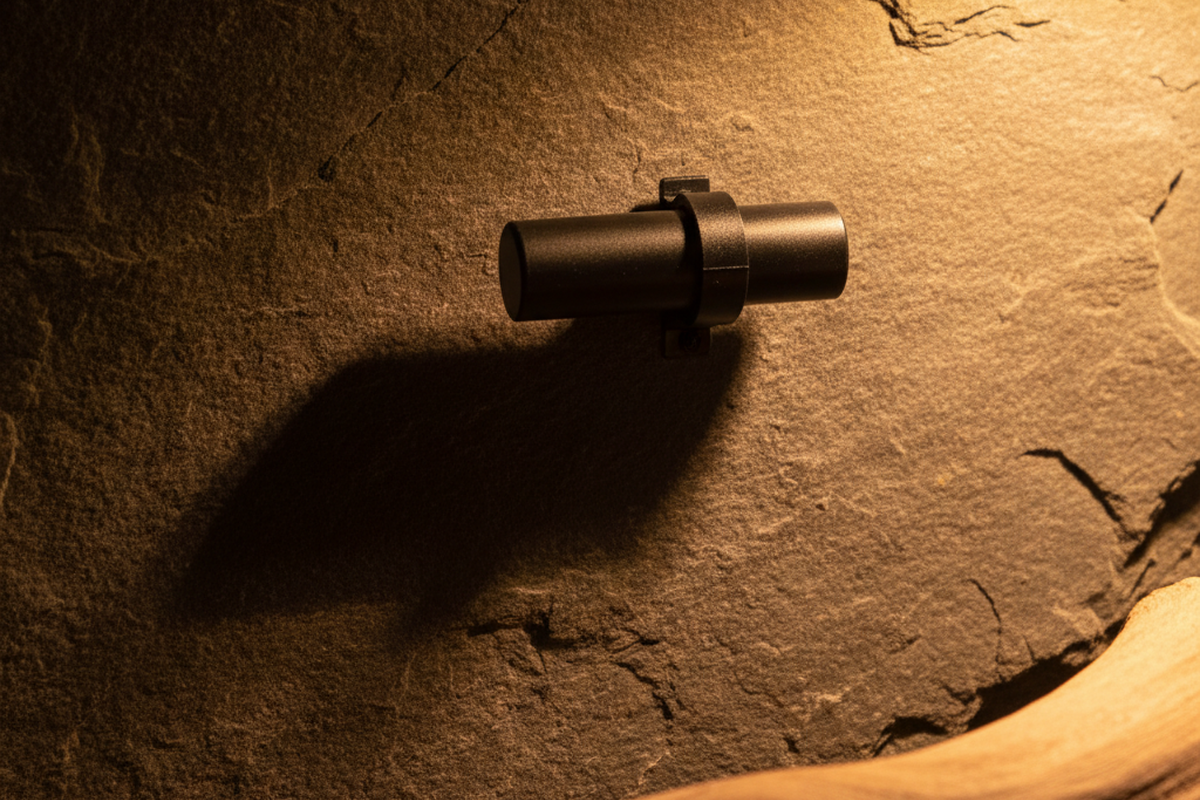It’s a familiar scenario with terrifying stakes. An aging parent wakes in the middle of the night, disoriented and needing the bathroom. They step into a dark hallway. In the few seconds it takes to find a light switch or fumble with a phone, they are navigating in near-total darkness. This is the moment falls happen. For an older adult, even a minor slip in a hallway can lead to fractures, head injuries, or a loss of confidence that steals their mobility and independence.
Falls are the leading cause of injury-related death for adults over 65, and many of these happen at night in transitional spaces like hallways. The critical failure isn’t a lack of lighting; it’s the gap between entering a dark space and the light turning on. A delay of even three seconds is enough time for a disoriented person to misjudge a step, trip over an obstacle, or lose their balance. Any lighting solution for aging adults must eliminate this gap.
The solution is a specific class of motion-activated lighting: systems built on passive infrared sensors that deliver a true instant-on response. When paired with the right light levels, color temperatures, and timeout settings, these systems can eliminate a preventable, life-altering risk. This guide provides the technical principles to implement a hallway lighting system that is automatic, reliable, and optimized for the unique needs of older adults.
Why a Dark Hallway Is a High-Risk Environment
Aging affects vision, balance, and reaction time, magnifying the danger of a dark hallway. The process of dark adaptation, by which our eyes adjust to low light, slows dramatically with age. A younger person might adapt in 30 seconds, but an older adult can require several minutes to achieve the same visual acuity. During that period, they are functionally blind in a space they assume is familiar. Depth perception is poor, contrast is low, and the ability to spot a rug corner or a change in flooring is gone.
Hallways themselves present unique challenges. They are narrow, enclosed, and often cluttered with hazards: area rugs that shift, thresholds between rooms, or stray electrical cords. Unlike a bedroom, a hallway rarely has ambient light from windows. People also move through them with purpose; the urgency to reach the bathroom often overrides the caution needed to turn on a bright, jarring overhead light.
This combination of physical frailty, environmental hazards, and nighttime behavior creates the perfect storm for a fall. Many older adults wake up disoriented, especially if they are on medications that affect cognition. The simple act of deciding whether to turn on a light introduces a dangerous cognitive load when they are already unsteady. The ideal solution requires no decision and no action. The light must simply be on the moment they need it.
This is why motion-activated lighting is not a convenience for aging parents, but a necessary safety intervention. Any delay between movement and illumination is a failure. The system must be automatic and immediate, ensuring they never have to take a single step in the dark.
What “Instant-On” Really Means
For a lighting system to prevent falls, “instant-on” means the light reaches full brightness in under 500 milliseconds. This threshold isn’t arbitrary. It’s based on the distance an older adult can travel before a light appears and the time their brain needs to process the visual information to move safely.
Get Inspired by Rayzeek Motion Sensor Portfolios.
Doesn't find what you want? Don't worry. There are always alternate ways to solve your problems. Maybe one of our portfolios can help.
Consider the physics of a fall. An older adult moving cautiously at two feet per second will cover four to six feet in the three seconds a slow system takes to activate. In that time, they are already deep into the hallway and may have already encountered an obstacle. With the five-second delay common in app-dependent smart lights, they could traverse an entire hallway in darkness. The delay is the precise window in which a fall occurs.
True instant response is only possible with sensors that operate at the hardware level, free from network connections or software commands. This is the domain of Passive Infrared (PIR) sensors, which trigger a direct electrical response to body heat. Not all motion-activated lights are created equal, and many consumer-grade “smart” solutions fail to meet this critical safety standard.
How PIR Sensors Achieve Instant Response
A Passive Infrared (PIR) sensor works by detecting changes in the infrared radiation within its field of view. When a person enters its detection zone, their body heat creates a thermal signature that the sensor registers as motion. This immediately triggers a relay that closes an electrical circuit, powering the light.
The entire process is analog and self-contained. No signal is sent to a hub, no command is processed by software, and no bulb has to wake up from a low-power state. The result is a response time measured in fractions of a second. This hardware-based reliability is why PIR sensors are the standard for security lighting, industrial safety systems, and hospitals. For protecting an aging parent at home, the same standard must apply. A PIR-based system is a closed loop, independent of Wi-Fi, apps, or other external points of failure.
Why App-Dependent Smart Lights Introduce Dangerous Delays
This direct, hardware-based approach is the opposite of how most smart lighting systems work. These systems typically use a motion sensor that sends a wireless signal to a central hub. The hub then sends a command over Wi-Fi to a smart bulb, which finally powers on. This architecture introduces multiple points of latency and failure.
First is the communication delay. The round trip from sensor to hub to bulb can take two to five seconds, even on a perfect network. If the Wi-Fi is congested or the hub is busy, the delay can stretch to ten seconds or more. Second is the dependency failure. If the internet is down, the hub reboots, or an app update introduces a bug, the system may not respond at all. The person is left in darkness, and the technology meant to provide safety becomes a source of risk.
For an older adult navigating a hallway at night, a five-second delay isn’t a minor annoyance; it’s the difference between safety and a catastrophic fall. The system must be local, hardware-based, and instantaneous.
Choosing the Right Light: Brightness and Color
The ideal light must be bright enough to reveal obstacles but not so bright that it startles someone or disrupts their sleep. This balance is achieved with a light output between 30 and 100 lumens for a standard residential hallway.
The lower end of this range, 30 to 50 lumens, is like a dim nightlight and works for short hallways or those with good vision. The upper end, 80 to 100 lumens, is better for longer hallways, darker interiors, or individuals with significant vision impairment. For comparison, a standard 60-watt bulb produces 800 lumens—far too bright for this purpose. Such intense light would cause squinting and disorientation, defeating the entire purpose. When selecting a product, look for a specific lumen rating and avoid vague terms like “low mode.” The light level must be consistent and predictable.
Why Warm Color Temperature Is Essential
Color temperature, measured in Kelvin (K), is just as important as brightness. Lower values (2700K to 3000K) produce a warm, gentle, yellow-orange light. Higher values (5000K and up) produce a cool, harsh, blue-white light similar to daylight. For nighttime lighting, warm color temperature is a physiological necessity.
Aging eyes are more sensitive to the glare created by short-wavelength blue light. A sudden blast of cool, blue-rich light can be painful and disorienting. Warm light is gentler, produces less glare, and allows for comfortable navigation without squinting.
Equally important is the circadian factor. Blue light is a powerful suppressor of melatonin, the hormone that regulates sleep. Even brief exposure at night can disrupt the sleep cycle, making it difficult to fall back asleep. Warm light has a minimal impact on melatonin. For an older adult already struggling with fragmented sleep, the right color temperature can mean the difference between a quick trip to the bathroom and a sleepless night. Look for a fixture or bulb rated between 2700K and 3000K.
Looking For Motion-Activated Energy-Saving Solutions?
Contact us for complete PIR motion sensors, motion-activated energy-saving products, motion sensor switches, and Occupancy/Vacancy commercial solutions.
Setting the Right Timeout Duration
The timeout duration is how long the light stays on after motion is no longer detected. Many products default to 30 seconds or less, which is dangerously short for an older adult.
A person who is unsteady or using a walker moves slowly. A round trip to the bathroom could easily take 90 seconds. If the timeout is 30 seconds, the light will shut off while they are still in the hallway, plunging them back into darkness when they are most fatigued. This is the exact failure the system is meant to prevent. The problem is worse with some sensors that have a “cool-down” period after timing out, during which they won’t detect new motion for several seconds.
The only safe approach is to set the timeout to a minimum of 60 seconds, with a strong preference for 90 seconds or longer. Look for products with an adjustable timeout, often controlled by a small dial or switch, and treat this feature as non-negotiable. Test the setting by walking the hallway at your parent’s actual pace, including pauses, to ensure the light never turns off prematurely.
Sensor Placement: Leading the Way

Proper sensor placement determines whether the light is already on when a person enters the hallway or whether it turns on after they’ve taken a few steps in the dark. The light must lead, not chase. The sensor’s detection zone must cover the entry point, triggering the light before the first step is taken into the hallway.
PIR sensors have a cone-shaped detection zone. A ceiling-mounted sensor covers a wide area below it, while a wall-mounted sensor creates a more focused beam. To lead the way, position the sensor so that the farthest entry point is within its range. If the hallway is accessed from a bedroom, the sensor should detect a person standing in the doorway. This often means mounting a ceiling sensor within a few feet of the entry or aiming a wall sensor directly at it.
For hallways with turns or multiple entry points, a single sensor may not be enough. In these cases, use multiple sensors to cover each segment or a single sensor with adjustable sensitivity set to its highest level. The key is to test from every possible entry point.
If your parent uses a walker or moves very slowly, standard sensors may struggle to detect them. Look for models with adjustable sensitivity and set it to high. Aim the sensor to detect their upper body, which is less likely to be obscured by a mobility aid. The final test is simple: walk into the hallway at your parent’s pace. If you take even one step in darkness, the sensor must be repositioned.
Controlling Glare
A light that is too bright or shines directly into the eyes is just as dangerous as one that is too dim. Glare can cause temporary blindness, disorientation, or a startle response that leads to a fall.

The problem is direct exposure to the light source. A bare bulb, even a dim one, acts as a point of intense light. If positioned at eye level, it can overwhelm the retina. For an older adult whose eyes adapt slowly, this can cause functional blindness for several seconds after looking away.
The solution is to light the path, not the person.
Maybe You Are Interested In
- Choose Diffused Fixtures: Select fixtures with frosted covers, opal glass, or other diffusers that scatter the light, creating a soft, even glow instead of a harsh point.
- Aim Downward: If using a directional fixture, aim it down toward the floor at a 45-degree angle. This illuminates the walking path without shining into the eyes of someone standing, sitting, or who has fallen.
Test for glare by activating the light at night. Stand, crouch, and sit in the hallway. If the bulb is directly visible and harsh from any position, the fixture needs to be re-aimed or replaced.
Choosing the Right Hardware
Not all LED bulbs and fixtures work well with motion sensors. Look for LEDs rated for frequent on-off cycles, as cheaper bulbs can fail prematurely when switched multiple times a night. Also, seek out “flicker-free” bulbs, as the imperceptible flicker in some LEDs can cause discomfort or visual instability for sensitive aging eyes.
Integrated LED fixtures, where the light source and sensor are built into a single unit, are often the most reliable choice. They are designed to work together and eliminate compatibility issues.
While battery-powered lights are easy to install, they introduce a critical point of failure: dead batteries. They require constant maintenance and are less reliable than hardwired solutions. For a permanent safety installation, hardwired fixtures or switches are always the superior choice.
Installation: DIY or Professional?
The complexity of installation varies. Plug-in nightlights are simple but often too dim and poorly positioned. Battery-powered units are flexible but unreliable long-term. Hardwired solutions, such as motion-sensor wall switches or ceiling fixtures, are the most reliable but require electrical work.
Replacing a light switch or fixture involves handling live circuits and must comply with local electrical codes. If you lack experience with electrical work, hire a licensed electrician. The cost of professional installation is a small price to pay for the peace of mind that the system is safe and will work when it’s needed most.
Even if you hire a professional, you are now equipped with the exact specifications they need to follow: a PIR-based system, 30-100 lumens, a 2700K-3000K color temperature, a 90-second timeout, and sensor placement that leads the way. This ensures the final result is not just a motion light, but a true fall prevention system.



























